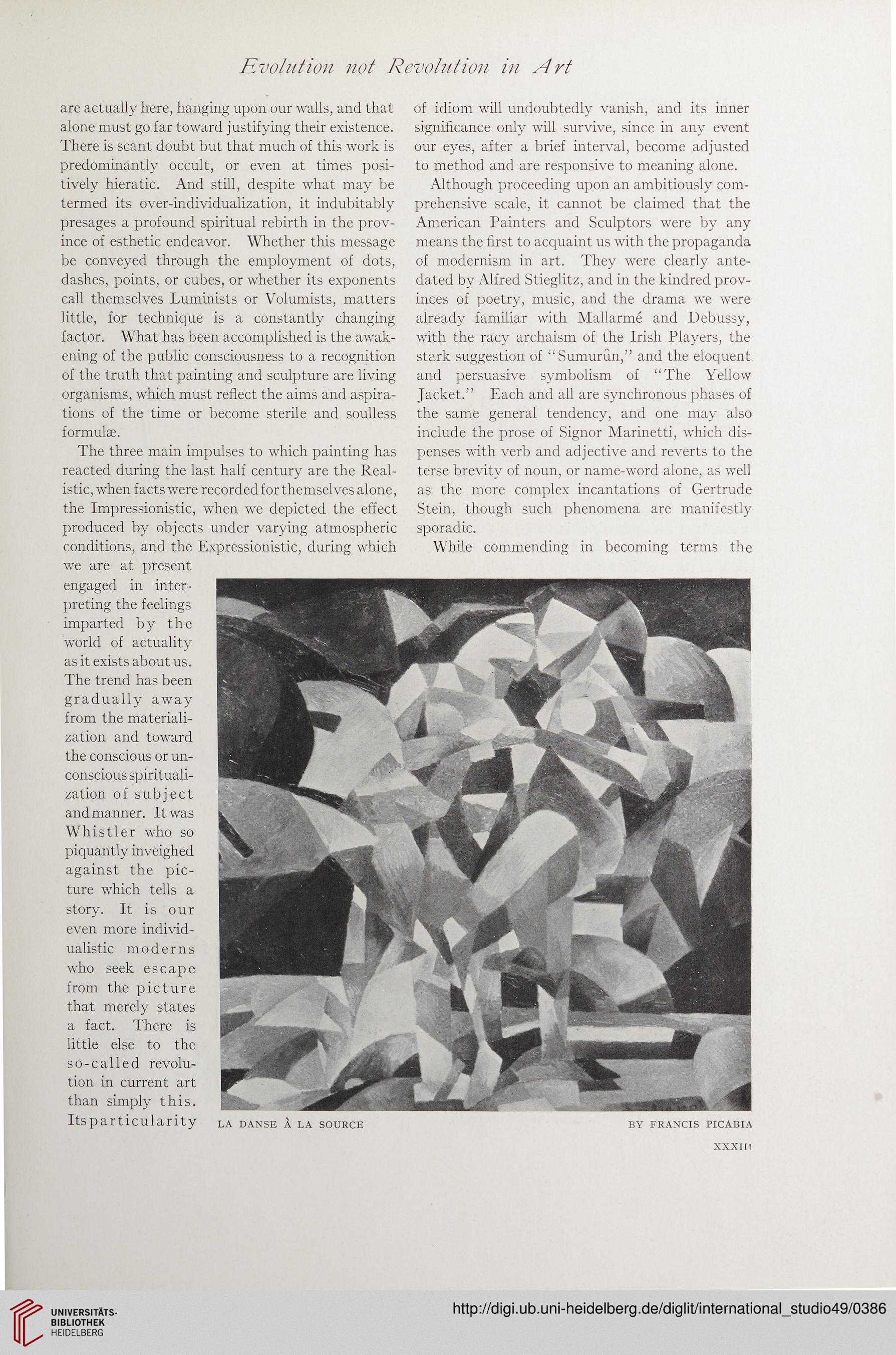Evolution not Revolution in Ant
are actually here, hanging upon our walls, and that
alone must go far toward justifying their existence.
There is scant doubt but that much of this work is
predominantly occult, or even at times posi-
tively hieratic. And still, despite what may be
termed its over-individualization, it indubitably
presages a profound spiritual rebirth in the prov-
ince of esthetic endeavor. Whether this message
be conveyed through the employment of dots,
dashes, points, or cubes, or whether its exponents
call themselves Luminists or Volumists, matters
little, for technique is a constantly changing
factor. What has been accomplished is the awak-
ening of the public consciousness to a recognition
of the truth that painting and sculpture are living
organisms, which must reflect the aims and aspira-
tions of the time or become sterile and soulless
formulae.
The three main impulses to which painting has
reacted during the last half century are the Real-
istic, when facts were recorded for themselves alone,
the Impressionistic, when we depicted the effect
produced by objects under varying atmospheric
conditions, and the Expressionistic, during which
we are at present
engaged in inter¬
preting the feelings
imparted by the
world of actuality
as it exists about us.
The trend has been
gradually away
from the materiali¬
zation and toward
the conscious or un¬
conscious spirituali¬
zation of subject
and manner. It was
Whistler who so
piquantly inveighed
against the pic¬
ture which tells a
story. It is our
even more individ¬
ualistic moderns
who seek escape
from the picture
that merely states
a fact. There is
little else to the
so-called revolu¬
tion in current art
than simply this.
Itsparticularity
of idiom will undoubtedly vanish, and its inner
significance only will survive, since in any event
our eyes, after a brief interval, become adjusted
to method and are responsive to meaning alone.
Although proceeding upon an ambitiously com-
prehensive scale, it cannot be claimed that the
American Painters and Sculptors were by any
means the first to acquaint us with the propaganda
of modernism in art. They were clearly ante-
dated by Alfred Stieglitz, and in the kindred prov-
inces of poetry, music, and the drama we were
already familiar with Mallarme and Debussy,
with the racy archaism of the Irish Players, the
stark suggestion of “Sumurun,” and the eloquent
and persuasive symbolism of “The Yellow
Jacket.” Each and all are synchronous phases of
the same general tendency, and one may also
include the prose of Signor Marinetti, which dis-
penses with verb and adjective and reverts to the
terse brevity of noun, or name-word alone, as well
as the more complex incantations of Gertrude
Stein, though such phenomena are manifestly
sporadic.
While commending in becoming terms the
LA DANSE A LA SOURCE BY FRANCIS PICABIA
XXXI11
are actually here, hanging upon our walls, and that
alone must go far toward justifying their existence.
There is scant doubt but that much of this work is
predominantly occult, or even at times posi-
tively hieratic. And still, despite what may be
termed its over-individualization, it indubitably
presages a profound spiritual rebirth in the prov-
ince of esthetic endeavor. Whether this message
be conveyed through the employment of dots,
dashes, points, or cubes, or whether its exponents
call themselves Luminists or Volumists, matters
little, for technique is a constantly changing
factor. What has been accomplished is the awak-
ening of the public consciousness to a recognition
of the truth that painting and sculpture are living
organisms, which must reflect the aims and aspira-
tions of the time or become sterile and soulless
formulae.
The three main impulses to which painting has
reacted during the last half century are the Real-
istic, when facts were recorded for themselves alone,
the Impressionistic, when we depicted the effect
produced by objects under varying atmospheric
conditions, and the Expressionistic, during which
we are at present
engaged in inter¬
preting the feelings
imparted by the
world of actuality
as it exists about us.
The trend has been
gradually away
from the materiali¬
zation and toward
the conscious or un¬
conscious spirituali¬
zation of subject
and manner. It was
Whistler who so
piquantly inveighed
against the pic¬
ture which tells a
story. It is our
even more individ¬
ualistic moderns
who seek escape
from the picture
that merely states
a fact. There is
little else to the
so-called revolu¬
tion in current art
than simply this.
Itsparticularity
of idiom will undoubtedly vanish, and its inner
significance only will survive, since in any event
our eyes, after a brief interval, become adjusted
to method and are responsive to meaning alone.
Although proceeding upon an ambitiously com-
prehensive scale, it cannot be claimed that the
American Painters and Sculptors were by any
means the first to acquaint us with the propaganda
of modernism in art. They were clearly ante-
dated by Alfred Stieglitz, and in the kindred prov-
inces of poetry, music, and the drama we were
already familiar with Mallarme and Debussy,
with the racy archaism of the Irish Players, the
stark suggestion of “Sumurun,” and the eloquent
and persuasive symbolism of “The Yellow
Jacket.” Each and all are synchronous phases of
the same general tendency, and one may also
include the prose of Signor Marinetti, which dis-
penses with verb and adjective and reverts to the
terse brevity of noun, or name-word alone, as well
as the more complex incantations of Gertrude
Stein, though such phenomena are manifestly
sporadic.
While commending in becoming terms the
LA DANSE A LA SOURCE BY FRANCIS PICABIA
XXXI11




